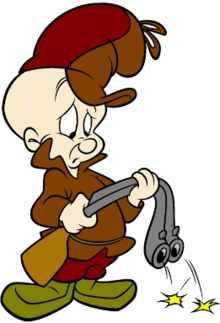
Back إلمر فاد Arabic Elmer Fadd Azerbaijani Елмър Фъд Bulgarian Elmer Fudd Catalan Elmer Fjot Danish Elmer Fudd German Elmer Gruñón Spanish المر فاد Persian Elmeri (piirroshahmo) Finnish Elmer Fudd French
| Elmer J. Fudd | |
|---|---|
| Looney Tunes/Merrie Melodies character | |
 | |
| First appearance | Little Red Walking Hood (November 6, 1937) (prototype version)[1][2] Elmer's Candid Camera (March 2, 1940) (official/finalized version) |
| Created by | Tex Avery Chuck Jones |
| Voiced by | Mel Blanc (1937–1939-1940, 1942, 1946, 1950, 1954, 1956–1957, 1959–1989) Danny Webb (1938–1939) Roy Rogers (1938, singing voice in A Feud There Was) Arthur Q. Bryan (1940–1959) Frank Graham (1944) Dave Barry (1958) Hal Smith (1960–1965) Paul Kuhn (1989) Jeff Bergman (1990–1992, 1997, 2002–2004, 2013–present) Greg Burson (1990–2001) Joe Alaskey (1992, 2000) Frank Welker (1993, 1995) Billy West (1996–2015) Tom Kenny (2004–2005) Brian Drummond (Baby Looney Tunes; 2002) Eric Bauza (2018, 2021–present) (see below) |
| In-universe information | |
| Alias | Elmer, Elmer Fudd (full name), Elmer J.[3] Fudd |
| Species | Human |
| Gender | Male |
| Occupation | Hunter |
| Relatives | Louie (uncle) Judd (uncle) Electro J. Fudd (descendant) |
Elmer J.[4] Fudd is an animated cartoon character in the Warner Bros. Looney Tunes/Merrie Melodies series and the archenemy of Bugs Bunny. Elmer Fudd's aim is to hunt Bugs, but he usually ends up seriously injuring himself and other antagonizing characters. He exhibits the speech sound disorder known as rhotacism, replacing his Rs and Ls with Ws thus referring to Bugs Bunny as a "scwewy" (screwy) or "wascawwy (rascally) wabbit." Elmer's signature catchphrase is, "Shhh. Be vewy vewy quiet, I'm hunting wabbits", as well as his trademark laugh.
The best known Elmer Fudd cartoons include Chuck Jones' work What's Opera, Doc?, the Rossini parody Rabbit of Seville, and the "Hunting Trilogy" of "Rabbit Season/Duck Season" shorts (Rabbit Fire, Rabbit Seasoning, and Duck! Rabbit, Duck!) with Fudd, Bugs Bunny, and Daffy Duck. An earlier prototype of character named Elmer had some of Fudd's recognizable aspects before the character's more conspicuous features were set.